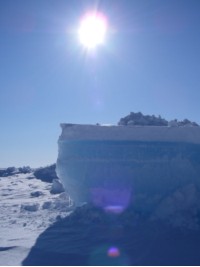The amount of UV radiation to the Arctic is increasing
Why?
The sun emits ultraviolet (UV) rays, large doses of which are hazardous to humans, ani-mals and plants. Increased UV radiation may cause disturbances in the immune system, cataracts and cancer in humans. It also has damaging effects on fish and amphibians, and may disturb the photosynthesis of plants, both in the sea and on land.
 The sun and blocks of sea ice.
Illustration: Sebastian Gerland, NPI
The ozone layer is crucial for the amounts of UV rays that reach the earth. A thick, well-functioning ozone layer allows fewer hazardous UV rays through than a damaged ozone layer does. The world became aware of the problems associated with the thinning of the ozone layer and increasing amounts of UV radiation reaching the earth several decades ago. It was emissions of the subsequently banned chlorofluorocarbons (CFC gases) from spray boxes and other sources which broke down the ozone layer. Ozone depletion was most marked over the polar regions and the ozone holes here are still large, particularly in the Antarctic.
The sun and blocks of sea ice.
Illustration: Sebastian Gerland, NPI
The ozone layer is crucial for the amounts of UV rays that reach the earth. A thick, well-functioning ozone layer allows fewer hazardous UV rays through than a damaged ozone layer does. The world became aware of the problems associated with the thinning of the ozone layer and increasing amounts of UV radiation reaching the earth several decades ago. It was emissions of the subsequently banned chlorofluorocarbons (CFC gases) from spray boxes and other sources which broke down the ozone layer. Ozone depletion was most marked over the polar regions and the ozone holes here are still large, particularly in the Antarctic.
The ozone hole and changes in climate are interlinked. The increasing greenhouse effect heats the lowest part of the atmosphere, while the upper part is cooled. The ozone layer is in the upper part, which becomes cold. When the temperature is sufficiently low in this part of the atmosphere, a larger number of beautiful mother-of-pearl clouds form, and such clouds strongly intensify the breakdown of ozone. This takes place because reactions in the clouds cause the sunlight to form chlorine compounds which, in turn, break down the ozone layer.
What is taking place?
The cold climate and the low sun make polar life particularly vulnerable. The arctic regions receive most of the increase in UV radiation in spring. If, in addition, the layer of snow and ice disappears due to enhanced warming, species which are normally protected by snow and ice will be more exposed to UV radiation.
Some organisms have evolved special strategies to protect themselves from UV radiation and can also repair some UV damage. In an ecosystem, UV damage in phytoplankton can change the plankton communities and, in turn, affect higher levels in the food chain because the availability and quality of food for these species are changed. Changes in one link in the food chain will thus have impacts on the community as a whole.
Did you know...
 UV stress reduces photosynthetic activity in some phytoplankton, which means that more UV radiation will reduce the ability of the sea to absorb CO2.
UV stress reduces photosynthetic activity in some phytoplankton, which means that more UV radiation will reduce the ability of the sea to absorb CO2.